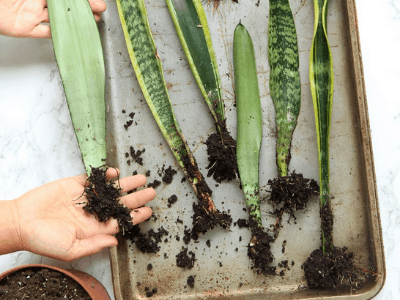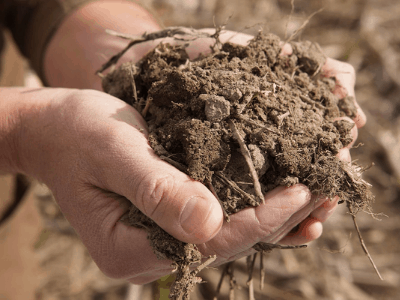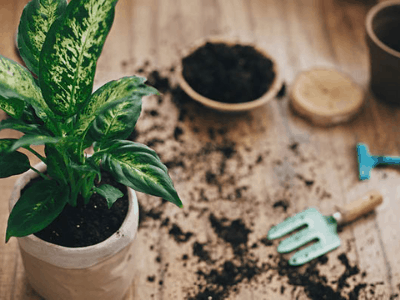Change the Soil of Your Snake Plants
Are your indoor plants in need of soil changes regularly and should you do this at regular intervals?
Can you tell me how often to change them, and does it matter when you do this?
If you are asking yourself these questions then you probably think that it’s time…
…to give your indoor plants some fresh soil. So let’s see, how often should indoor plants be given fresh soil?
The soil of indoor plants rarely needs to be changed. It should be replaced only when the plant no longer fits…
…into its current pot or when the soil becomes very hard. You may change the soil no more than once a year.
The main reasons you should replace potted soil in a houseplant are when the plant grows out of its pot…
…and when the soil becomes hard.
Also, you can try adding fresh soil to your indoor plants if you notice they haven’t been growing for a while…
…wilt a few days after watering, or have discolored leaves.
So all of that sounds easy-peasy, but it’s not quite that simple.
Changing the soil greatly depends on the type and size of the plants, how much the plant grows…
…and how the soil is conditioned. Let’s look at this further.
Before that, here we have the story of Sonny about having an very first time experience…
..changing the soil of potted snake plant.
Here’s the story of Sonny.
The soil of a potted plant was changing in her pot.
It seemed like it had gone from the dirt she usually picked out of people’s gardens and into some type of moist…
…brown sludge that smelled like old gym socks.
Well I think its the time for repotting and changing the soil for the plant.
Man I really dont have a idea how to do it.
So I ask Claire if she can help me repotting and changing soil of the this plant…
…cause I know this girl can do gardening, she’s been doing it for 5 years.
The day has come, she came up to my house and in no time she really doing it fast.
Bang, bang, bang, voila. My snake plant soil now has been changed!
Thanks to her now I know how to do it, and now I can do it without her.

The best time to do this repotting is in the late winter or very early spring. This puts the transplant during the time of year that the plant’s not in active growth mode.
Kevin Espiritu, Founder of epicgardening.com
Here’s the main thing for you
When to Change the Soil?
My experience shows that people who intend to change the soil for indoor plants are prone to make three mistakes:
Changing the soil too early. People love their house just as much as plants love their their house.
So better to not do this. Changing the soil during the wrong season.
In order for your plant to thrive, you should research and make use of the conditions that the weather offers.
Changing the soil instead of repotting. The soil should be left in place while it has many nutrients….
…and the plant is comfortable with it, otherwise it will cause the plant much damage.
It is not uncommon for potting soil (usually years, but could be months if it is not high-quality)…
…to become compressed over time, closing up air and water spaces, so the plant cannot get adequate nutrition.
If this occurs, the soil will become hard and it will be easy enough to notice and replace with fresh stuff.
It is also possible that some white, fuzzy granules gather on the potting soil, which indicates mold.
Nevertheless, you shouldn’t underestimate the differences between the types of plants, so let’s break it down.
Plants that grow extremely fast need new soil every year, as well as a new bigger pot.
For instance, Devil’s Ivy grows so fast that she soon gets too big for her pot…
…so repotting her helps her thrive even more. However, plants that grow slowly, like Cacti…
…only require fresh soil about once every two years.
This is because they normally attach themselves to their pot and feel more comfortable…
…in it for an extended period of time.
Additionally, soil replacement can stress the plant, so you should only make that change…
…if it is absolutely necessary, such as when repotting for instance.
This guide offers general guidelines for changing soil in indoor plants…
…but you will usually be able to tell when your houseplant needs a fresh boost by replacing the old soil with new…
…so you can follow your instinct on this.

Go on…
Changing the Soil or Repotting?
You can change the soil by replacing the old one with a new one, filled with fresh nutrients…
…while repotting is just relocating a plant to a new container and doesn’t always involve soil changing.
In general, it all depends on the type of plant you have.
If you don’t know which kind of care to give your indoor plants, don’t worry, it’s perfectly normal.
Hopefully, this will help.

General Rules for Repotting
When the root system of your houseplant has taken the shape of the pot, repotting it is generally recommended.
Repotting the plant is also a good option if it can no longer grow in its current pot and you want to give it more room to grow.
Your houseplant may need to be replanted if it has not shown any new growth…
…for a while (about a season) but appears healthy without it. It will benefit from fresh soil.
Unless anything from the above happens, you can simply change the soil of a houseplant.
If you don’t have enough room, you can add fresh soil. But when it comes to indoor plants, things are different.

Next…
General Rules for Changing the Soil
If the soil of your house plant is hardened, it’s time to change it.
Touch the soil with your fingertips, if it feels dense and compact, then your plant needs some fresh, new soil.
It’s important to change the soil in your indoor plant if you haven’t done so for more than three or four years….
…despite that the soil appears and feels normal. Adding fresh soil will boost your houseplant’s freshness….
…particularly if its foliage appears dull and it could use some overall rejuvenation.
It is obvious there is a distinction between changing the soil of your houseplant and repotting it.
You should consider each option separately, but this does not mean you cannot combine…
…them to create a suitable environment for your indoor plant to thrive.
When is Best to Change The Soil?
Change the soil for indoor plants usually takes place in spring or summer.
During this time is the ideal moment for repotting, so that they can get a larger pot…
…and nourishment boost from fresh soil.
It should be noted, however, that this rule is not applicable to all plants. Cacti, for instance, are an exception to this rule.
In January or February is the ideal time to change the soil of a cactus because it undergoes active growth during the dry season.
If your indoor plants need fresh soil, it will be especially happy for them.
It is recommended to add a fresh and change the soil patch to a pot if your plant seems…
…to need a boost for some reason.

What do You Get Out of It?
It can be stressful for an indoor plant to change the soil or to be repotted.
A responsible plant owner should know that for houseplants to thrive…
…it is best to keep them in their nursery-like environment. But this is not always the best thing for your houseplant.
As we know, there are a few good reasons why you might want to change the soil in your indoor plants.
So let’s learn what happens when you change the soil:
Next up…
The plant will begin to grow
You might notice an immediate improvement in a plant’s growth and health after change the soil…
if it hasn’t shown new growth for a long time. Sometimes your indoor plants just need plenty of fresh soil…
…full of nutrients so that they can grow and thrive!
New leaves and flowers will appear
When your indoor plant need to change the soil, you can expect new tiny leaves to appear, as well as baby blooms.
If you have to do this, it is quite clear that your plant is rooting for some new soil to begin with.
It can stay the same and that’s okay
Indoor plants whose soil has recently been changed tend to stay the same. Even if you change the soil…
…and expect them to work wonders, they may not, for a variety of reasons.
Perhaps the plant is not that particular about the soil it grows in.
Similarly, aloe and devil’s ivy, two of the most hardy plants, will survive and grow just fine…
…even if they are not given fresh soil. So much so that if fresh soil is added, nothing major is noticed.
Last but not least..
It can look like it is dying
Change the soil can cause your plant to wilt, drop some leaves, or even begin to die back if its roots are disturbed.
You should have patience and give your plant some time to adjust if this happens.
In this case, the change came as a shock to the plant, used to it’s old soil.
Do not worry, as long as your houseplant continues to receive adequate amounts of water and light…
…it will normally recover soon.
While I’m sure you’re well versed in changing the soil in indoor plants by now…
…there are a few other things to keep in mind. Don’t use garden soil for indoor plants.
It does not contain the same nutrients as potting soil.
Potting soil is made up of organic material that has been composted and is enriched with fertilizer.
It makes the plant grow healthier and more resistant to diseases and pests.
You can reuse potting soil if the soil is still light and fluffy. Houseplants can become attached to their pots…
…and growing environments, so if for some reason you must change the soil but it still appears usable…
…don’t throw it away! Before using it again, you should consider doing these things:
Turn the old soil, move it around and take a very good look at it.
As long as the soil is still fluffy and not too dense and compact, and there are no bugs within…
…it is perfectly fine to reuse it. Remove extra organic matter.
Remove all older wigs and leaves, as well as the roots, if they don’t look healthy.
Healthy roots are creamy-white and firm; otherwise, cut them to encourage the plant to grow new roots.
Add nutrients to the old soil. As the old soil has already provided nutrients to the plant…
…its nutritional value has weakened over time.
Therefore, you should enrich the old soil with some plant food before placing it back in the pot.
After you have become an expert in changing soil, I encourage you to assess your plants.
Make sure your indoor plants have the right soil before change the soil for it by using your newly acquired knowledge.
Sum Up
See having snake plant is good choice for you to have! It’s cool, its famous, it’s easy to have and care!
What else do you need? In this pandemic time like this, is a good choice for you to have an new activity…
…and having snake plant is a good choice for you to have!
Conclusion
Last thing for sure. This plant need to be care carefully, remember plant need the “love” too.
There are still many recent and interesting articles about snake plants
Alright that’s all for today! Do you have any questions about all of this?
Or do you want to add some tips and guide to change the soil from the potted snake plant?
Let me know your recommendation from the comment below.
I hope you can now take care your snake carefully and grow it big!
As well as other unique information from All Things Gardener.
For further information and other inquiries you can contact us here
Thanks for reading this article! Bye!

